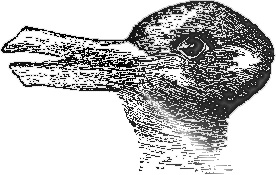
| Rabbit-Duck Illusion | |

An ambiguous figure in which the brain switches between seeing a rabbit and a duck. The duck-rabbit was "originally noted" by American psychologist Joseph Jastrow (Jastrow 1899, p. 312; 1900; see also Brugger and Brugger 1993). Jastrow used the figure, together with such figures as the Necker cube and Schröder stairs, to point out that perception is not just a product of the stimulus, but also of mental activity (Kihlstrom 2002).
Jastrow's cartoon was based on one originally published in Harper's Weekly (Nov. 19, 1892, p. 1114) which, in turn, was based on an earlier illustration in Fliegende Blätter, a German humor magazine (Oct. 23, 1892, p. 147).
Interestingly, children tested on Easter Sunday are more likely to see the figure as a rabbit, whereas when tested on a Sunday in October, they tend to see it as a duck (Brugger and Brugger 1993, Kihlstrom 2002). Brugger and Brugger (1993) has provided a comprehensive catalog of duck-rabbit variants, along with data on their ease of reversibility.
![]()
Brugger, P. and Brugger, S. "The Easter Bunny in October: Is It Disguised as a Duck?" Perceptual Motor Skills 76, 577-578, 1993.
Fliegende Blätter. October 23, 1892, p. 147.
Gombrich, E. H. Art and Illusion. New York: Pantheon, p. 5, 1960.
Jastrow, J. "Minor Contributions. Studies from the Laboratory of Experimental Psychology of the University of Wisconsin." Amer. J. Psych. 3, 43-58. 1890.
Jastrow, J. "The Mind's Eye." Popular Sci. Monthly 54, 299-312, 1899.
Jastrow, J. Fact and Fable in Psychology. Boston: Houghton Mifflin, 1900.
Jastrow, J. The Subconscious. New York: Houghton Mifflin, 1906.
Jastrow, J. "The Administrative Peril in Education." Popular Sci. Monthly 81, 495-515, 1912.
Jastrow, J. "Conflict of Psychologies." Sci. Monthly 29, 411-416, 1929.
Jastrow, J. "Joseph Jastrow." In A History of Psychology in Autobiography (Ed. C. Murchison). Worcester, MA: Clark University Press, pp. 135-162, 1930a.
Jastrow, J. Keeping Mentally Fit: A Guide to Everyday Psychology. Garden City, NY: Garden City Publishing, 1930b.
Jastrow, J. Piloting Your Life; the Psychologist as Helmsman. New York: Greenberg, 1930c.
Jastrow, J. "Has Psychology Failed?" Amer. Scholar 4, 261-269, 1935.
Kid's World. "Optical Illusions--2." http://www.frontiernet.net/~docbob/ilusion2.htm.
Kihlstrom, J. F. "Letter to the Editor." Trends Cognitive Sci. 6, 502, 2002.
Malach, R.; Levy, I.; and Hasson, U. "The Topography of High-Order Human Object Areas." Trends Cogn. Sci. 6, 178-184, 2002.
Peterson, M. A.; Kihlstrom, J. F.; Rose, P. M.; and Glisky, M. L. "Mental Images Can be Ambiguous: Reconstruals and Reference-Frame Reversals." Memory and Cogn. 20, 107-123, 1992.
Popplestone, J. A. M. An Illustrated History of American Psychology, 2nd ed. Akron, OH: University of Akron Press, 1994.
"Rabbit and Duck." Harper's Weekly 36, No. 1874, p. 1114, Nov. 19, 1892.
Scheidemann, N. V. Experiments in General Psychology. Chicago: University of Chicago Press, p. 67, 1939.
Wittgenstein, L. Philosophical Investigations. Oxford, England: Blackwell, pp. 165-166, 1953/1958.
CITE THIS AS:
Weisstein, Eric W. "Rabbit-Duck Illusion." From MathWorld--A Wolfram Web Resource. http://mathworld.wolfram.com/Rabbit-DuckIllusion.html







































No comments:
Post a Comment